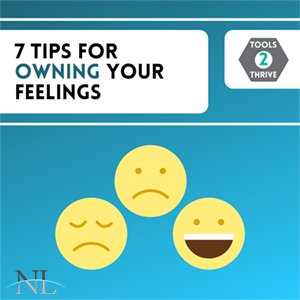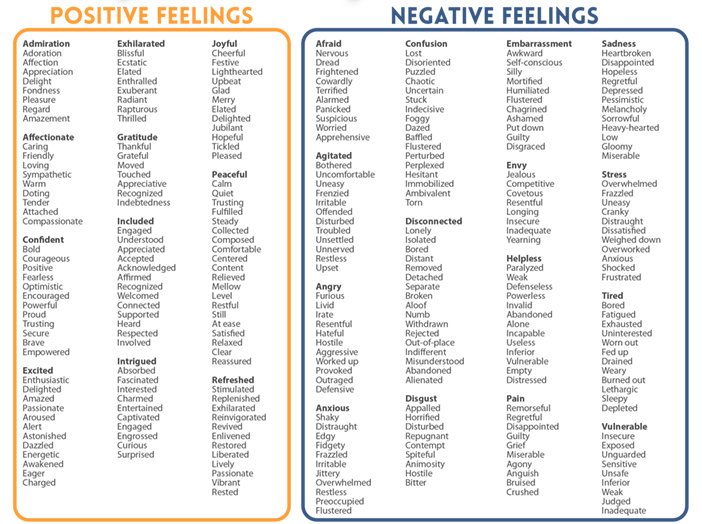Owning Your Feelings

While 1 in 5 people will experience a mental illness during their lifetime, everyone faces challenges in life that can impact their mental health. The good news is there are practical tools that everyone can use to improve their mental health and increase resiliency – and there are ways that everyone can be supportive of friends, family, and co-workers who are struggling with life’s challenges or their mental health.
This May is Mental Health Month and New Life Counseling is highlighting #Tools2Thrive – what individuals can do daily to prioritize their mental health, build resiliency in the face of trauma and obstacles, support those who are struggling, and work towards a path of recovery.
When it comes to your feelings, It can be easy to get caught up in your emotions as you’re feeling them. Most people don’t think about what emotions they are dealing with, but taking the time to really identify what your feeling can help you to better cope with challenging situations. Here are some tips to help you with this:
1. Allow yourself to feel: Sometimes there are societal pressures that encourage people to shut down their emotions, often expressed through statements like, “Big girls don’t cry,” or “Man up.” These outdated ideas are harmful, not helpful. Everyone has emotions- they are part of the human experience- and you have every right to feel them, regardless of gender, sexual orientation, ethnicity, socio-economic status, race, political affiliation or religion.
2. Don’t ignore how you’re feeling. Most of us have heard the term “bottling up your feelings” before. When we try to push feelings aside without addressing them, they build strength and make us more likely to “explode” at some point in the future. It may not always be appropriate to process your emotions at the very moment you are feeling them, but try to do so as soon as you can.
3. Talk it out. Find someone you trust that you can talk to about how you’re feeling. You may find that people are eager to share about similar experiences they’ve had or times that they have felt the way that you are feeling. This can be helpful, but if you’re really only interested in having someone listen, it’s okay to tell them that.
4. Build your emotional vocabulary. When asked about our feelings, most people will usually use words like bad, sad, mad, good, or _ne. But at the root of “good, bad, sad, mad, or fine” are many words that better describe how we feel. Try building your emotional vocabulary by writing down as many “feeling” words as you can think of and think of a time that you felt that way.
5. Try journaling. Each night write down at least 3 feelings you had over the course of the day and what caused them. It doesn’t need to be a “Dear Diary” kind of thing. Just a few sentences or bullet points to help you practice being comfortable with identifying and expressing your emotions.
6. Consider the strength of your feelings. By thinking about how intense your emotions are, you may realize that what you thought you were feeling at first could better be described by another word. For instance, sometimes a person might say they are stressed when what they are really experiencing is something less severe like annoyance, alternatively anger might really be a stronger, deeper feeling like betrayal.
7. See a mental health professional. If you are taking steps to be more in touch with your feelings, but are having trouble dealing with them, mental health providers like counselors and therapists have been trained to help. New Life Counseling has 14 counselors available to help you. We take Blue Cross Blue Shield, and a few of our counselors take United Health, Aetna, Cigna, Midland’s Choice, or Tricare. We also have a private pay option. Please call or office or use the contact form to find out which counselor may be a good fit for you. If you have Medicaid/Medicare, or Title 19 there are some free or low cost options available- Call the number on the back of your card and they can give you a list of providers that take your insurance. Your employer might also have an Employee Assistance Program (EAP) that offers a limited number of free counseling sessions, and your Human Resources department can help you access this resource. If you don’t have an EAP through work, the leaders of religious organizations like churches, synagogues and mosques often have limited experience with counseling.
What’s Underneath?
Taking time to slow down and identify what we are really experiencing can help us feel better and can improve our communications and relationships with others.
Using the prompts below, think of a specific action (this could be something you did, or something someone else did) or event and fill in the blank to identify what’s underneath. The feelings list below can help you build your mental collection of feelings. This type of activity takes practice, but once you start doing it you’ll find it easier over time.
1. I felt BAD when _____________(action or event). But what I was really feeling was _________, _______, and __________.
2. I felt SAD when _____________(action or event). But what I was really feeling was _________, _______, and __________.
3. I felt MAD when _____________(action or event). But what I was really feeling was _________, _______, and __________.
4. I felt GOOD when ___________ (action or event). But what I was really feeling was _________, _______, and __________.
5. I felt HAPPY when ___________(action or event). But what I was really feeling was _________, _______, and __________.

For each of us, the tools we use to keep us mentally healthy will be unique. But New Life Counseling wants everyone to know that mental illnesses are real, and recovery is possible. Finding what work for you may not be easy but can be achieved by gradually making small changes and building on those successes. By developing your own #Tools2Thrive, it is possible to find balance between work and play, the ups and downs of life, and physical health and mental health – and set yourself on the path to recovery.
This post was adapted from The Mental Health America Tools2Thrive toolkit. For more information, visit www.mhanational.org/may. You can also take a mental health screen at mhascreening.org. It’s a quick, free, and private way for people to assess their mental health and recognize signs of mental health problems.
